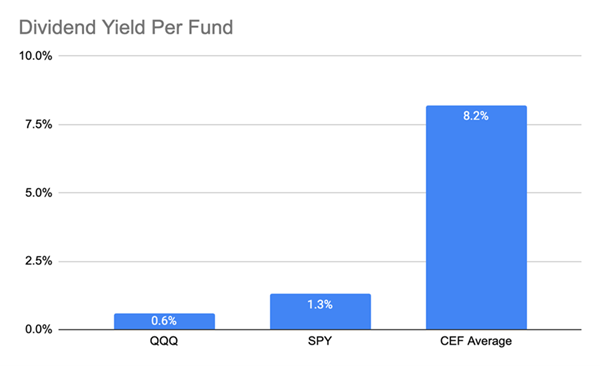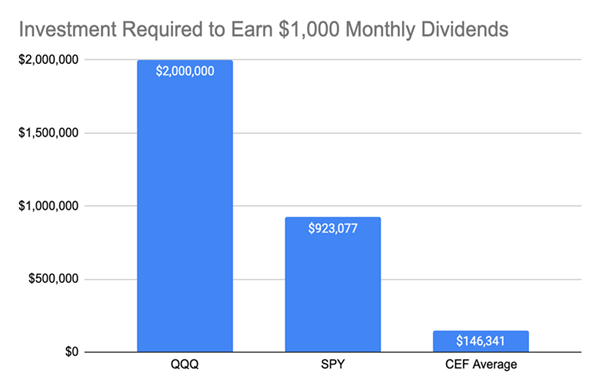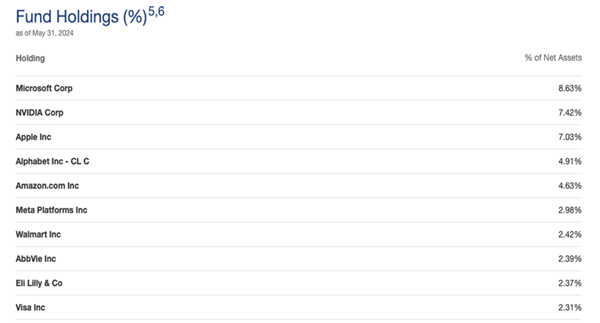What if I told you I’ve found a way to get $1,000 in dividends every single month—and you only need to invest $146,364 to get it?
There’s more, too, because this $1,000 monthly income stream comes from:
- Regular stocks: What I’m about to show you is based on stocks you likely hold now. I’m talking blue chips like NVIDIA (NVDA), Microsoft (MSFT) and Walmart (WMT). The key is to buy these stocks through a special vehicle called …
- A closed-end fund (CEF). These ridiculously overlooked funds hold the same assets as ultra-popular ETFs but yield a lot more—8.2% on average. Many CEFs (like the one we’ll cover in a sec) also pay dividends monthly.
Look at how CEFs’ yields compare to those on the benchmark index funds for the NASDAQ (the Invesco QQQ Trust (QQQ)) and the S&P 500 (the SPDR S&P 500 ETF Trust (SPY)), as of this writing.
It’s not even close!

Source: CEF Insider
CEFs fund those huge payouts in many ways, but the main route is by rotating their portfolios to take profits on winners, then handing those profits out as dividends.
With monthly paying CEFs you can basically replace a paycheck with an investment. And the amount of cash you need to invest to generate our $1,000 a month is, well, tiny with CEFs compared to what you’d need to pile into an ETF.

Source: CEF Insider
If we want $1,000 a month in passive income, we’d need to invest $2 million in QQQ. While it’s a bit less than a million to get the same from SPY, we only need $146,341, as of this writing, to get that same income from a typical CEF.
Now let’s go deeper and choose a specific CEF, the Eaton Vance Risk-Managed Diversified Equity Income Fund (ETJ). This one yields more than the average CEF, at 8.8%, bringing our $1,000-a-month target further within reach. We’d need just $136,364 to get that with ETJ, a savings of over $1,864,000 on the NASDAQ index fund.
Moreover, ETJ trades at a 7.5% discount to net asset value (NAV, or the value of its holdings). These discounts only exist with CEFs, and they mean we’re getting ETJ’s holdings for a bit less than 93 cents on the dollar.
It gets better. Let’s look at ETJ’s portfolio:

Source: Eaton Vance
This list is close to QQQ’s top holdings. And the non-NASDAQ stocks, such as Eli Lilly & Co. (LLY), Visa (V) and Walmart, are in the S&P 500.
ETJ has larger concentrations of Visa and Walmart than the S&P 500 because the fund tries to manage risk (it’s right in the name!). By selling some shares of its high performers, like NVIDIA, to fund its monthly payout, ETJ has become less risky than the index funds, which have seen NVIDIA become a bigger part of their holdings.
The key takeaway is that ETJ gets us a portfolio very close to what you’d get in an index fund but with less risk and more income.
More specifically, ETJ gives us exposure to the same high-quality, high-flying stocks that have soared in 2024 while being more mindful of the possibility that those stocks may be overbought while other stocks are oversold.
In mitigating risk this way, ETJ frees up cash to fund its dividend. Which is why it’s built to give investors as much of their return as possible as a monthly income stream, unlike low-yielding QQQ and SPY.
Let’s recap what we’ve uncovered with ETJ:
- ETJ offers a far cheaper income stream than QQQ and SPY—selling at 7.5% below its portfolio value—while holding many of the same stocks.
- ETJ is less risky than the index funds.
- ETJ yields more than the index funds.
- ETJ pays dividends monthly.
This fund is just the start of the opportunity available to us in CEFs. There are many more like it, and many of those have bigger income streams and greater upside. So while ETJ sounds extraordinary (especially to folks who limit themselves to index funds!), it’s actually pretty run of the mill for a CEF.
I’m Not Going to Lie: ETJ Is Lousy Compared to These Monthly Payers
ETJ is fine if you’re looking for an entry level CEF. But we can easily beat it, both in yield and on the discount front, too.
The bottom line here is we can get that same $1,000 a month but with even less invested. And more upside, too. The key is the “9.2% Monthly Payer Portfolio” I want to give you exclusive access to now.
As the name says, it pays 9.2%, so we can get our $1,000 a month on just $130,445 invested. And thanks to the deep discounts each of these 5 CEFs currently sport, my research suggests 20%+ price upside, too.
The time to buy them is now. Click here to learn more and unlock your own 9.2% income stream, paid every single month.

Recent Comments